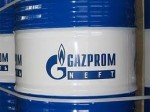 Russia’s Gazprom Neft, the oil arm of state-controlled energy giant Gazprom, is considering developing the Caspian and Black sea offshore deposits but the Black Sea projects may pay off only if the oil giant is granted tax breaks, a Gazprom Neft official said on Thursday.
Russia’s Gazprom Neft, the oil arm of state-controlled energy giant Gazprom, is considering developing the Caspian and Black sea offshore deposits but the Black Sea projects may pay off only if the oil giant is granted tax breaks, a Gazprom Neft official said on Thursday.
“Gazprom Neft plans to take part in tenders and auctions for new deposits, which are of interest to the company. This refers both to onshore and offshore deposits,” said Viktor Savelyev, head of Gazprom Neft’s exploration and production directorate.
Saveleyev said Gazprom Neft had started working on Russian shelves long ago.
“We worked in its most unexplored sector – the Bering Sea, in the Russian part of the Pacific Ocean where the first well was drilled in 2002. We also explored the East Shmidtovsky section on the northern shelf of Sakhalin,” he said.
“Importantly, our scientific and technical center has never interrupted work to study the most promising offshore targets for licensing. We have prepared applications for blocks on the Pechora, Kara and Chukotka sea shelves. Today, the development of offshore fields is a strategic priority for Gazprom Neft. However, the company will implement its first shelf project abroad,” he said.
Savelyev said in 2010 Gazprom Neft had signed a production sharing agreement on two offshore exploration blocks with Equatorial Guinea’s Energy Ministry and its national oil company GEPetrol. Gazprom Neft is the project’s operator. The proven and probable oil reserves of the two blocks are estimated at 110 million metric tons.
“Our immediate plans are to start geological prospecting on the Cuban shelf. In this case, we will work jointly with Malaysian Petronas. The proven and probable reserves are estimated at 400 million metric tons of oil. The project is very attractive in terms of sales and logistics as the huge American market is so close,” he said.
“The Caspian shelf is also attractive for us, while the Black Sea offshore oil and gas projects may become attractive only if we receive tax breaks similar to tax privileges granted to develop offshore deposits in the northern seas. In particular, we are keeping an eye on the Tuapse Trough and other areas of the Black Sea,” Savelyev said.
He added that Gazprom Neft intends to produce at least 10% of hydrocarbons or about 10 million tons of conventional fuel from its overseas projects by 2020 in line with its development strategy.
“The first step in this direction was the acquisition of Serbia’s Naftna Industrija Srbije. After that, Gazprom Neft signed a contract to develop Iraq’s Badra oilfield. The company is also working as part of the National Oil Consortium in Venezuela,” Savelyev said.
“We are also carrying out active work to join African projects and are considering options of onshore and offshore deposit development in Cuba. The company is also studying CIS states, including Kazakhstan and Turkmenistan,” Savelyev said, adding that each of the projects would be started with geological surveys.
Gazprom Neft plans to become an oil production leader in the Yamal-Nenets autonomous district in northeast Russia, and probably on the Barents Sea shelf. Moreover, there are plans to develop deposits in East Siberia and the Nenets autonomous district in Russia’s north, he said.
“Our strategic goal is to raise the company’s recoverable reserves to 2.2 billion tons, which will let us produce about 100 million tons of oil equivalent by 2020,” he added.
Windows to Russia!
- Germany’s BASF to enter South Stream project (windowstorussia.com)
- Gazprom studies ways of delivering more LNG to quake-hit Japan (windowstorussia.com)
- Gazprom may extend gas contract with Slovenia from 2017 to 2035 (windowstorussia.com)
- Russia ready to disengage liquefied gas for Japan… (windowstorussia.com)
- Russia hopes Turkey will approve South Stream (coffee.windowstorussia.com)